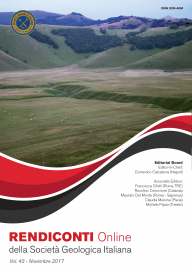
Geochemistry of groundwater in a sector of the Colline Metallifere mining district (Tuscany, Italy)
Cristoforo Russo (a), Stefano Bianchi (b), Giuseppe Protano (a) & Massimo Salleolini (a)
(a) Department of Physical, Earth and Environmental Sciences, University of Siena, Via del Laterino, 8, 53100, Siena, Italy.
(b) Geologist, Via Roma, 99, Follonica, Italy.
Corresponding author e-mail: russocristoforo@gmail.com
DOI: https://doi.org/10.3301/ROL.2017.29
Volume: 43/2017
Pages: 5-10
Abstract
This paper reports the results of a geochemical study of groundwater in the Montioni area, a sector of the Colline Metallifere mining district (Tuscany, Italy). The aim of the study was to distinguish the hydrochemical facies of groundwater, to define their origin and flow systems, and to identify the main geochemical processes ruling their chemical composition. The physico-chemical parameters (temperature, pH, electrical conductivity and redox potential) and concentrations of major ions (Na, K, Ca, Mg, Cl, HCO3 and SO4) measured in 203 groundwater samples collected in the period 1996-2014 from four springs and three piezometers, were used for this study. The analytical data suggests that the Montioni area is characterized by a complex hydrogeological system consisting of three main groundwater types: (1) Ca-SO4 waters of the deep regional aquifer system hosted by Triassic carbonate-evaporite formations, rising through fractures and faults; (2) Ca(Na)-HCO3 and Na-HCO3(Cl) waters fed by recent meteoric recharge and characterized by shallow circulation within calcareous-siliceous and clayey-calcareous-arenaceous formations of the Tuscan Nappe, respectively; (3) Ca-SO4-HCO3 waters arising by mixing of deep Ca-SO4 fluids and shallow Ca(Na)-HCO3 groundwater. The main processes determining the geochemical features of groundwater in the study area are: (1) carbonate dissolution (mainly calcite) in the surface recharge zone, as well as sulphate (gypsum and anhydrite) and carbonate (calcite and dolomite) dissolution in the deep aquifer hosted by Triassic carbonate-evaporite lithologies; (2) ion exchange reactions occurring in the surface water circulation system within clayey rocks of the Tuscan Nappe (Scaglia Toscana Group); (3) mixing of deep and shallow groundwater.
Keywords
groundwater, hydrochemical facies, water-rock interaction, mixing, Colline Metallifere mining district.
Get Full Text